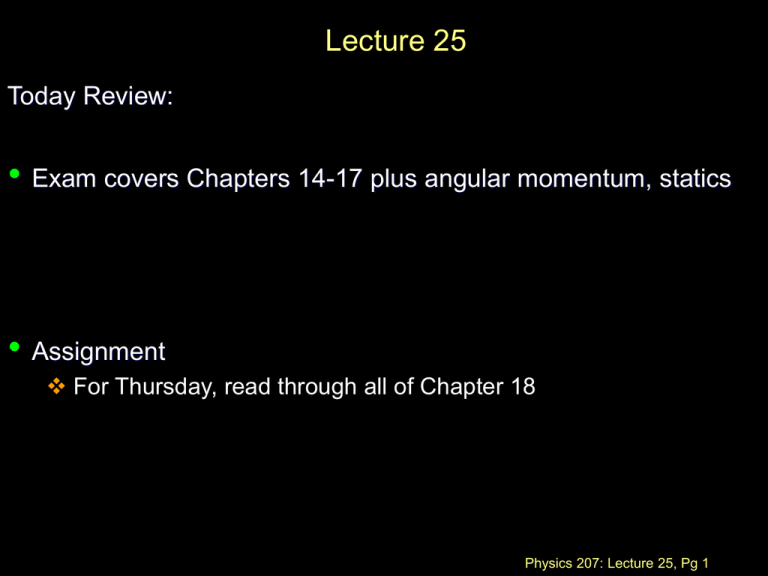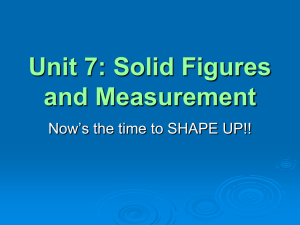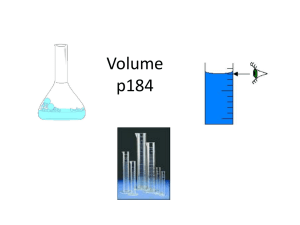sy25_apr22_10
advertisement

Lecture 25 Today Review: • Exam covers Chapters 14-17 plus angular momentum, statics • Assignment For Thursday, read through all of Chapter 18 Physics 207: Lecture 25, Pg 1 Angular Momentum Exercise A mass m=0.10 kg is attached to a cord passing through a small hole in a frictionless, horizontal surface as in the Figure. The mass is initially orbiting with speed wi = 5 rad / s in a circle of radius ri = 0.20 m. The cord is then slowly pulled from below, and the radius decreases to r = 0.10 m. What is the final angular velocity ? Underlying concept: Conservation of Momentum ri wi Physics 207: Lecture 25, Pg 2 Angular Momentum Exercise A mass m=0.10 kg is attached to a cord passing through a small hole in a frictionless, horizontal surface as in the Figure. The mass is initially orbiting with speed wi = 5 rad / s in a circle of radius ri = 0.20 m. The cord is then slowly pulled from below, and the radius decreases to r = 0.10 m. What is the final angular velocity ? No external torque implies ri DL = 0 or Li = Lc Ii wi = If wf wi I for a point mass is mr2 where r is the distance to the axis of rotation m ri2wi = m rf2 wf wf = ri2wi / rf2 = (0.20/0.10)2 5 rad/s = 20 rad/s Physics 207: Lecture 25, Pg 3 Example: Throwing ball from stool A student sits on a stool, initially at rest, but which is free to rotate. The moment of inertia of the student plus the stool is I. They throw a heavy ball of mass M with speed v such that its velocity vector has a perpendicular distance d from the axis of rotation. What is the angular speed wF of the student-stool system after they throw the ball ? M Mv r wF I Top view: before d I after Physics 207: Lecture 25, Pg 4 Example: Throwing ball from stool What is the angular speed wF of the student-stool system after they throw the ball ? Process: (1) Define system (2) Identify Conditions (1) System: student, stool and ball (No Ext. torque, L is constant) (2) Momentum is conserved (check |L| = |r| |p| sin q for sign) Linit = 0 = Lfinal = - M v d + I wf M v wF I Top view: before d I after Physics 207: Lecture 25, Pg 5 Walking the plank… A uniform rectangular beam of length L= 5 m and mass M=40 kg is supported, but not attached, to two posts which are length D=3 m apart. A child of mass W=20 kg starts walking along the beam. 20 kg 40 kg 5m 3m Assuming infinitely rigid posts, how close can the child get to the right end of the beam without it falling over? [Hint: The upward force exerted by the beam on the left cannot be negative – this is the limiting condition on how far the child can be to the right. Set up the static equilibrium condition with the pivot about the left end of the beam.] Physics 207: Lecture 25, Pg 6 Walking the plank… A uniform rectangular beam of length L= 5 m and mass M=40 kg is supported, but not attached, to two posts which are length D=3 m apart. A child of mass W=20 kg starts walking along the beam. NL NR 0.5 m 400 N 200 N Sum of forces and torques are zero As the child walks from left to right NL goes from positive to “negative” If NL < 0 (a pull) then the board will tip. Choose blue dot as pivot point. Physics 207: Lecture 25, Pg 7 Walking the plank… A uniform rectangular beam of length L= 5 m and mass M=40 kg is supported, but not attached, to two posts which are length D=3 m apart. A child of mass W=20 kg starts walking along the beam. NL NR 0.5 m 400 N 200 N S t = 0 = -NL x 3 + 400 x 0.5 + NR x 0 - d 200 0= 0 + 200 +0 - d 200 d = 1 meter from pivot point which is 2.0 meter from right side distance to end (2 – 1) meters or 1 meter Physics 207: Lecture 25, Pg 8 Velocity and Acceleration Position: x(t) = A cos(wt + ) Velocity: v(t) = -wA sin(wt + ) Acceleration: a(t) = -w2A cos(wt + ) xmax = A vmax = wA amax = w2A k by taking derivatives, since: dx ( t ) v( t ) dt a( t ) dv ( t ) dt m 0 x Physics 207: Lecture 25, Pg 9 Measuring g To measure the magnitude of the acceleration due to gravity, g, in an unorthodox manner, a student places a ball bearing on the concave side of a flexible speaker cone . The speaker cone acts as a simple harmonic oscillator whose amplitude is A and whose frequency w can be varied. The student can measure both A and w. The equations of motion for the speaker are Position: y(t) = A cos(wt + ) Velocity: vy(t) = -wA sin(wt + ) Acceleration: ay (t) = -w2A cos(wt + ) If the ball bearing is in contact with the speaker, then S Fy = may= - mg+ N so that N = mg + may N = mg - mw2A cos(wt + ) Maximum: N = mg + mw2A Minimum: mg - mw2A but must be > 0! Physics 207: Lecture 25, Pg 10 Ideal Fluid Bernoulli Equation P1+ ½ r v12 + r g y1 = constant A 5 cm radius horizontal pipe carries water at 10 m/s into a 10 cm radius. ( rwater =103 kg/m3 ) What is the pressure difference? v P1+ ½ r v12 = P2+ ½ r v22 2 DP = ½ r v22 - ½ r v12 y 2 2 2 DP = ½ r (v2 - v1 ) v DV 1 p and A1 v1 = A2 v2 2 y 1 p 1 DP = ½ r v22 (1 – (A2/A1 ) 2 ) = 0.5 x 1000 kg/m x 100 m2/s2 (1- (25/100)2 ) = 47000 Pa Physics 207: Lecture 25, Pg 11 A water fountain A fountain, at sea level, consists of a 10 cm radius pipe with a 5 cm radius nozzle. The water sprays up to a height of 20 m. What is the velocity of the water as it leaves the nozzle? What volume of the water per second as it leaves the nozzle? What is the velocity of the water in the pipe? What is the pressure in the pipe? How many watts must the water pump supply? Physics 207: Lecture 25, Pg 12 A water fountain A fountain, at sea level, consists of a 10 cm radius pipe with a 5 cm radius nozzle. The water sprays up to a height of 20 m. What is the velocity of the water as it leaves the nozzle? Simple Picture: ½mv2=mgh v=(2gh)½ = (2x10x20)½ = 20 m/s What volume of the water per second as it leaves the nozzle? Q = A vn = 0.0025 x 20 x 3.14 = 0.155 m3/s What is the velocity of the water in the pipe? An vn = Ap vp vp = Q /4 = 5 m/s What is the pressure in the pipe? 1atm + ½ r vn2 = 1 atm + DP + ½ r vp2 1.9 x 105 N/m2 How many watts must the water pump supply? Power = Q r g h = 0.0155 m3/s x 103 kg/m3 x 9.8 m/s2 x 20 m = 3x104 W Physics 207: Lecture 25, Pg 13 Fluids Buoyancy A metal cylinder, 0.5 m in radius and 4.0 m high is lowered, as shown, from a massles rope into a vat of oil and water. The tension, T, in the rope goes to zero when the cylinder is half in the oil and half in the water. The densities of the oil is 0.9 gm/cm3 and the water is 1.0 gm/cm3 What is the average density of the cylinder? What was the tension in the rope when the cylinder was submerged in the oil? Physics 207: Lecture 25, Pg 14 Fluids Buoyancy r = 0.5 m, h= 4.0 m roil = 0.9 gm/cm3 rwater = 1.0 gm/cm3 What is the average density of the cylinder? When T = 0 Fbuoyancy = Wcylinder Fbuoyancy = roil g ½ Vcyl.+ rwater g ½ Vcyl. Wcylinder = rcyl g Vcyl. rcyl g Vcyl. = roil g ½ Vcyl.+ rwater g ½ Vcyl. rcyl = ½ roill.+ ½ rwater What was the tension in the rope when the cylinder was submerged in the oil? Use a Free Body Diagram ! Physics 207: Lecture 25, Pg 15 Fluids Buoyancy r = 0.5 m, h= 4.0 m Vcyl. = p r2 h roil = 0.9 gm/cm3 rwater = 1.0 gm/cm3 What is the average density of the cylinder? When T = 0 Fbuoyancy = Wcylinder Fbuoyancy = roil g ½ Vcyl.+ rwater g ½ Vcyl. Wcylinder = rcyl g Vcyl. rcyl g Vcyl. = roil g ½ Vcyl.+ rwater g ½ Vcyl. rcyl = ½ roill.+ ½ rwater = 0.95 gm/cm3 What was the tension in the rope when the cylinder was submerged in the oil? Use a Free Body Diagram! S Fz = 0 = T - Wcylinder + Fbuoyancy T = Wcyl - Fbuoy = g ( rcyl .- roil ) Vcyl T = 9.8 x 0.05 x 103 x p x 0.52 x 4 .0 = 1500 NPhysics 207: Lecture 25, Pg 16 Fluids Buoyancy r = 0.5 m, h= 4.0 m Vcyl. = p r2 h roil = 0.9 gm/cm3 rwater = 1.0 gm/cm3 What is the average density of the cylinder? When T = 0 Fbuoyancy = Wcylinder . rcyl = ½ roill.+ ½ rwater = 0.95 gm/cm3 What was the tension in the rope when the cylinder was submerged in the oil? Use a Free Body Diagram! S Fz = 0 = T - Wcylinder + Fbuoyancy T = Wcyl - Fbuoy = g ( rcyl .- roil ) Vcyl T = 9.8 x 0.05 x 103 x p x 0.52 x 4 .0 = 1500 N Physics 207: Lecture 25, Pg 17 A new trick Two trapeze artists, of mass 100 kg and 50 kg respectively are testing a new trick and want to get the timing right. They both start at the same time using ropes of 10 m in length and, at the turnaround point the smaller grabs hold of the larger artist and together they swing back to the starting platform. A model of the stunt is shown at right. How long will this stunt require if the angle is small ? Physics 207: Lecture 25, Pg 18 A new trick How long will this stunt require? Period of a pendulum is just w = (g/L)½ T = 2p (L/g)½ Time before ½ period Time after ½ period So, t = T = 2p(L/g)½ = 2p sec Key points: Period is one full swing and independent of mass (this is SHM but very different than a spring. SHM requires only a linear restoring force.) Physics 207: Lecture 25, Pg 19 Example A Hooke’s Law spring, k=200 N/m, is on a horizontal frictionless surface is stretched 2.0 m from its equilibrium position. A 1.0 kg mass is initially attached to the spring however, at a displacement of 1.0 m a 2.0 kg lump of clay is dropped onto the mass. The clay sticks. M What is the new amplitude? k m M m k -2 0(≡Xeq) 2 Physics 207: Lecture 25, Pg 20 Example A Hooke’s Law spring, k=200 N/m, is on a horizontal frictionless surface is stretched 2.0 m from its equilibrium position. A 1.0 kg mass is initially attached to the spring however, at a displacement of 1.0 m a 2.0 kg lump of clay is dropped onto the mass. M What is the new amplitude? Sequence: SHM, collision, SHM k m ½ k A02 = const. ½ k A02 = ½ mv2 + ½ k (A0/2)2 M k ¾ k A02 = m v2 v = ( ¾ k A02 / m )½ m ½ v = (0.75*200*4 / 1 ) = 24.5 m/s -2 0(≡Xeq) 2 Conservation of x-momentum: mv= (m+M) V V = mv/(m+M) V = 24.5/3 m/s = 8.2 m/s Physics 207: Lecture 25, Pg 21 Example A Hooke’s Law spring, k=200 N/m, is on a horizontal frictionless surface is stretched 2.0 m from its equilibrium position. A 1.0 kg mass is initially attached to the spring however, at a displacement of 1.0 m a 2.0 kg lump of clay is dropped onto the mass. The clay sticks. M What is the new amplitude? Sequence: SHM, collision, SHM k m V = 24.5/3 m/s = 8.2 m/s ½ k Af2 = const. M ½ k Af2 = ½ (m+M)V2 + ½ k (Ai)2 k m A 2 = [(m+M)V2 /k + (A )2 ]½ f i Af2 = [3 x 8.22 /200 + (1)2 ]½ Af2 = [1 + 1]½ Af2 = 1.4 m Key point: K+U is constant in SHM -2 0(≡Xeq) 2 Physics 207: Lecture 25, Pg 22 Fluids Buoyancy & SHM A metal cylinder, 0.5 m in radius and 4.0 m high is lowered, as shown, from a rope into a vat of oil and water. The tension, T, in the rope goes to zero when the cylinder is half in the oil and half in the water. The densities of the oil is 0.9 gm/cm3 and the water is 1.0 gm/cm3 Refer to earlier example Now the metal cylinder is lifted slightly from its equilibrium position. What is the relationship between the displacement and the rope’s tension? If the rope is cut and the drum undergoes SHM, what is the period of the oscillation if undamped? Physics 207: Lecture 25, Pg 23 Fluids Buoyancy & SHM Refer to earlier example Now the metal cylinder is lifted Dy from its equilibrium position. What is the relationship between the displacement and the rope’s tension? 0 = T + Fbuoyancy – Wcylinder T = - Fbuoyancy + Wcylinder T =-[rog(h/2+Dy) Ac+rwgAc(h/2-Dy)] + Wcyl T =-[ghAc(ro +rw)/2 + Dy gAc(ro -rw)]+ Wcyl T =-[Wcyl + Dy gAc(ro -rw)]+ Wcyl T = [ g Ac (rw -ro) ] Dy If the is rope cut, net force is towards equilibrium position with a proportionality constant g Ac (rw -ro) [& with g=10 m/s2] If F = - k Dy then k = g Ac (ro -rw) = p/4 x103 N/m Physics 207: Lecture 25, Pg 24 Fluids Buoyancy & SHM A metal cylinder, 0.5 m in radius and 4.0 m high is lowered, as shown, from a rope into a vat of oil and water. The tension, T, in the rope goes to zero when the cylinder is half in the oil and half in the water. The densities of the oil is 0.9 gm/cm3 and the water is 1.0 gm/cm3 If the rope is cut and the drum undergoes SHM, what is the period of the oscillation if undamped? F = ma = - k Dy and with SHM …. w = (k/m)½ where k is a “spring” constant and m is the inertial mass (resistance to motion), the cylinder So w = (1000p /4 mcyl)½ = (1000p / 4rcylVcyl)½ = ( 0.25/0.95 )½ = 0.51 rad/sec T = 3.2 sec Physics 207: Lecture 25, Pg 25 Underdamped SHM if x(t ) A exp - 2btm cos(wt ) ( wo b / 2m ) If the period is 2.0 sec and, after four cycles, the amplitude drops by 75%, what is the time constant t if t ≡ 2m / b ? 1.2 1 Four cycles implies 8 sec 0.8 0.6 So 0.4 A 0.2 0.25 A0 = A0 exp(-8b / 2m) 0 -0.2 ln(1/4)= -8 1/t -0.4 -0.6 -0.8 t = -8/ ln(1/4) = 5.8 sec -1 wt Physics 207: Lecture 25, Pg 26 Anti-global warming or the nuclear winter scenario Assume P/A = P = 1340 W/m2 from the sun is incident on a thick dust cloud above the Earth and this energy is absorbed, equilibrated and then reradiated towards space where the Earth’s surface is in thermal equilibrium with cloud. Let e (the emissivity) be unity for all wavelengths of light. What is the Earth’s temperature? P= A T4= (4p r2) T4 = P p r2 T = [P / (4 x )]¼ = 5.710-8 W/m2 K4 T = 277 K (A little on the chilly side.) Physics 207: Lecture 25, Pg 27 Time for a swim At solar equinox, how much could you reasonably expect for the top 1 meter of water in a lake at 45 deg. latitude to warm on a calm but bright sunny day assuming that the sun’s flux (P/A) is 1340 W/m2 if all the sun’s energy were absorbed in that layer ? At 45 deg. , sin 45 deg or 0.7071 x 1340 or 950 W/m2 But only 6 hours of full sun So Q available is 6 x 60 x 60 seconds with 950 J/s/m2 Q = 2 x 107 J in one square meter Q = m c DT with m 103 kg/m3 and c = 4.2 x 103 J/kg-K about 5 K per day. Physics 207: Lecture 25, Pg 28 Q, W and DETH 0.20 moles of an ideal monoatomic gas are cycled clockwise through the pV sequence shown at right (ADCBA). (R = 8.3 J/K mol) What are the temperatures of the two isotherms? Fill out the table below with the appropriate values. (a) pV = nRT T = pV/nR TA = 16600 x 0.10 / (0.20 x 8.3) TA = 1000 K TB = 500 K (b) DETH=W + Q Ideal Gas at constant V Q = n CV DT Physics 207: Lecture 25, Pg 29 Ch. 12 |L|=mvrperpendicular Physics 207: Lecture 25, Pg 30 Ch. 12 Physics 207: Lecture 25, Pg 31 Hooke’s Law Springs and a Restoring Force Key fact: w = (k / m)½ is general result where k reflects a constant of the linear restoring force and m is the inertial response (e.g., the “physical pendulum” where w = (k / I)½ Physics 207: Lecture 25, Pg 32 Simple Harmonic Motion Maximum potential energy Maximum kinetic energy Physics 207: Lecture 25, Pg 33 Resonance and damping Energy transfer is optimal when the driving force varies at the resonant frequency. Types of motion Undamped Underdamped Critically damped Overdamped Physics 207: Lecture 25, Pg 34 Fluid Flow Physics 207: Lecture 25, Pg 35 Density and pressure Physics 207: Lecture 25, Pg 36 Response to forces Physics 207: Lecture 25, Pg 37 States of Matter and Phase Diagrams Physics 207: Lecture 25, Pg 38 Ideal gas equation of state Physics 207: Lecture 25, Pg 39 pV diagrams Physics 207: Lecture 25, Pg 40 Thermodynamics Physics 207: Lecture 25, Pg 41 Work, Pressure, Volume, Heat T can change! In steady-state T=constant and so heat in equals heat out Physics 207: Lecture 25, Pg 42 Gas Processes Physics 207: Lecture 25, Pg 43 Lecture 25 • Exam covers Chapters 14-17 plus angular momentum, statics • Assignment For Thursday, read through all of Chapter 18 Physics 207: Lecture 25, Pg 44








